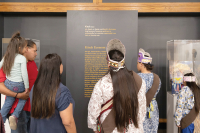Touch-me-nots and poison ivy
Jewelweed, or “touch-me-not,” is one of the most appealing wildflowers commonly encountered throughout Western North Carolina. Many recognize the plant from the time it appears in early spring as a pale green seedling, on through the long and showy summertime blossoming period, and into fall — when its pods become explosive mechanisms triggered by the slightest touch.
Two species are native to the southern highlands: spotted jewelweed (Impatiens carpensis), which has orange flowers with reddish-brown spots, and a nectar spur bent underneath and parallel to the flower; and pale jewelweed (I. pallida), which has lemon-yellow flowers only sparingly dotted with red markings, and a nectar spur bent at a right angle to the flower. Both flourish in moist woodland areas or alongside streams.
Thirty years ago, I didn’t see too much pale jewelweed. But in recent years it seems to be dominating its cousin, spotted jewelweed. Extensive segments of the roadside embankments along the Blue Ridge Parkway are now swathed in the yellow-flowered species. I don’t know why this change has occurred. I doubt that it’s global warming.
The common name jewelweed probably refers to the way water beads up on its leaves. Some maintain, however, that this designation refers to the plant’s robin-egg blue seeds.
The common name touch-me-not undoubtedly refers to the plant’s method of seed dispersal. The seeds mature inside a tightly coiled capsule. This capsule “explodes” when fully ripe or when activated by human touch.
Spotted jewelweed flowers have small openings that favor pollination by hummingbirds and insects that can hover. The small opening forces pollinators to push past either the mature male stamens (which cover them with pollen) or past small green pistils (which receive pollen). To negate the possibility of self-pollination, a given flower is initially male before transforming into a female.
Related Items
Pale jewelweed has a much larger opening that favors insects like bumblebees. It is found in the lower elevations alongside spotted jewelweed. But in my experiencethe pale jewelweed is more prevalent in higher elevations. (My wife disagrees, maintaining that elevation has nothing whatsoever to do with species frequency.) There is an infrequently encountered cream-colored variant of pale jewelweed that sometimes occurs on cold, north-facing slopes at high elevations.
Various American Indian tribes, including the Cherokees, have put this plant to use as a skin salve. And many people to this day maintain that the sap from its succulent leaves and stems will cure or at least ease poison ivy itch. Others stoutly maintain that this medicinal application is a hoax. “Scientific” studies have supported both sides.
Dr. James A. Duke is one of this country’s most respected authorities in regard to botanical medicines. In The Green Pharmacy (NY: St. Martin’s Press, 1997), Duke made the following observations:
“I’m not the only fan of jewelweed for preventing the unpleasant symptoms that develop following exposure to poisonous plants ... whenever I teach a three-day class on medicinal herbs, I treat my students to a dramatic little demonstration. I find a poisonous plant, usually poison ivy [and] apply its juice to the sensitive undersides of both of my wrists. A minute or two later, I wipe one wrist with a ball of crushed jewelweed leaves and stems. Three days later, the wrist that I didn’t treat with jewelweed shows the typical itchy, blistery poison-plant rash. The wrist rubbed with jewelweed invariably shows much less of a rash, and sometimes none at all.”
Duke noted that Dr. Robert Rosen at Rutgers University isolated “the active ingredient in jewelweed” that “binds to the same molecular sites on the skin as urushiol,” the active poisonous agent in poison ivy.
I have, in the past, used jewelweed as an antidote for poison ivy. And I have found that it provides some relief. But the very best antidote, for me, is one that I only discovered within recent years. That’s Dawn dish detergent. Something in that brand of detergent, which is also a degreaser, seems to completely neutralize the effects of urushiol on my skin. I apply the detergent liberally to the irritated area and let it dry. After just a few minutes, there is almost immediate relief. And after an hour or so, the irritation is pretty much eradicated.
George Ellison wrote the biographical introductions for the reissues of two Appalachian classics: Horace Kephart’s Our Southern Highlanders and James Mooney’s History, Myths, and Sacred Formulas of the Cherokees. In June 2005, a selection of his Back Then columns was published by The History Press in Charleston as Mountain Passages: Natural and Cultural History of Western North Carolina and the Great Smoky Mountains. Readers can contact him at P.O. Box 1262, Bryson City, N.C., 28713, or at This email address is being protected from spambots. You need JavaScript enabled to view it..









